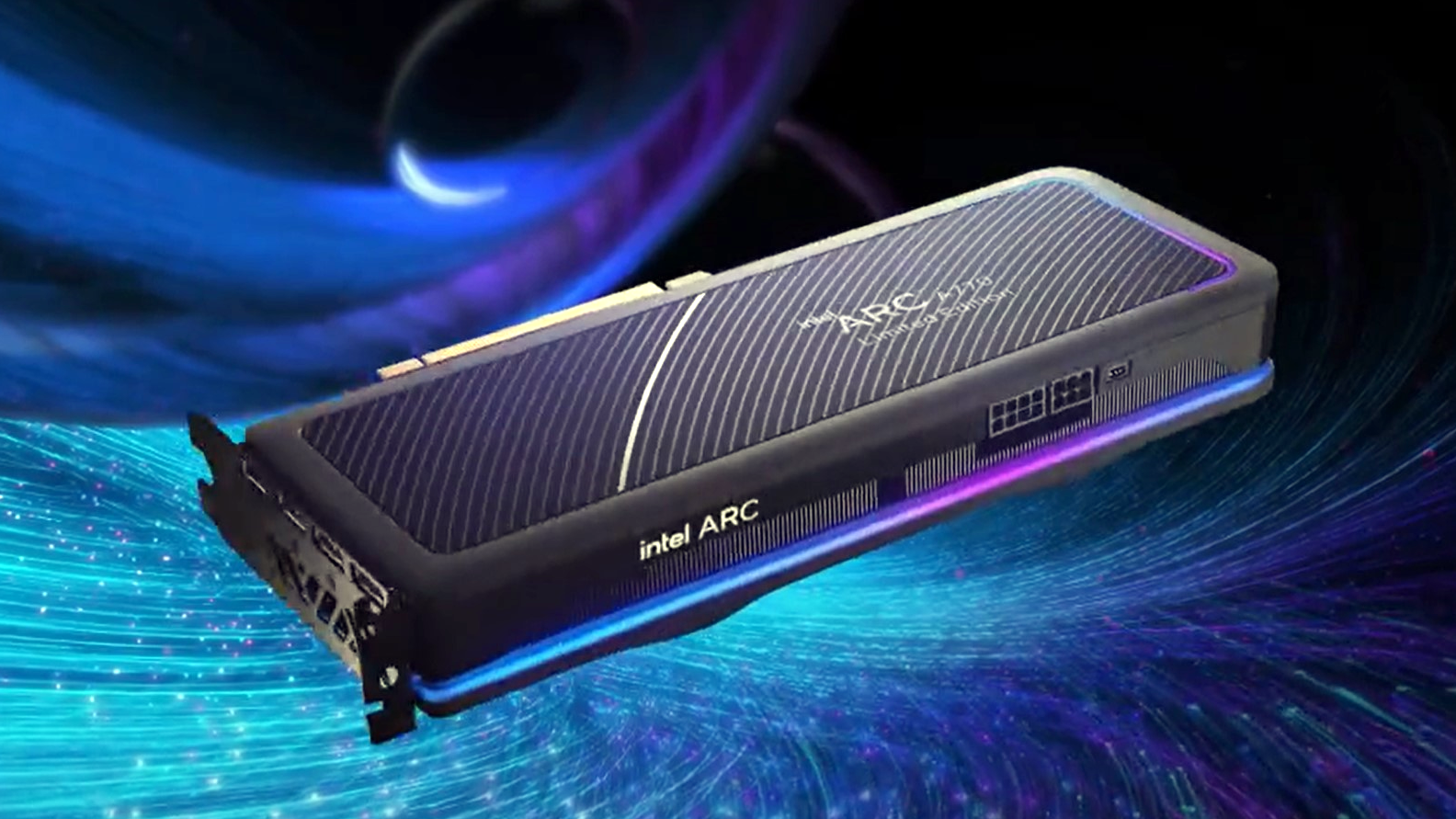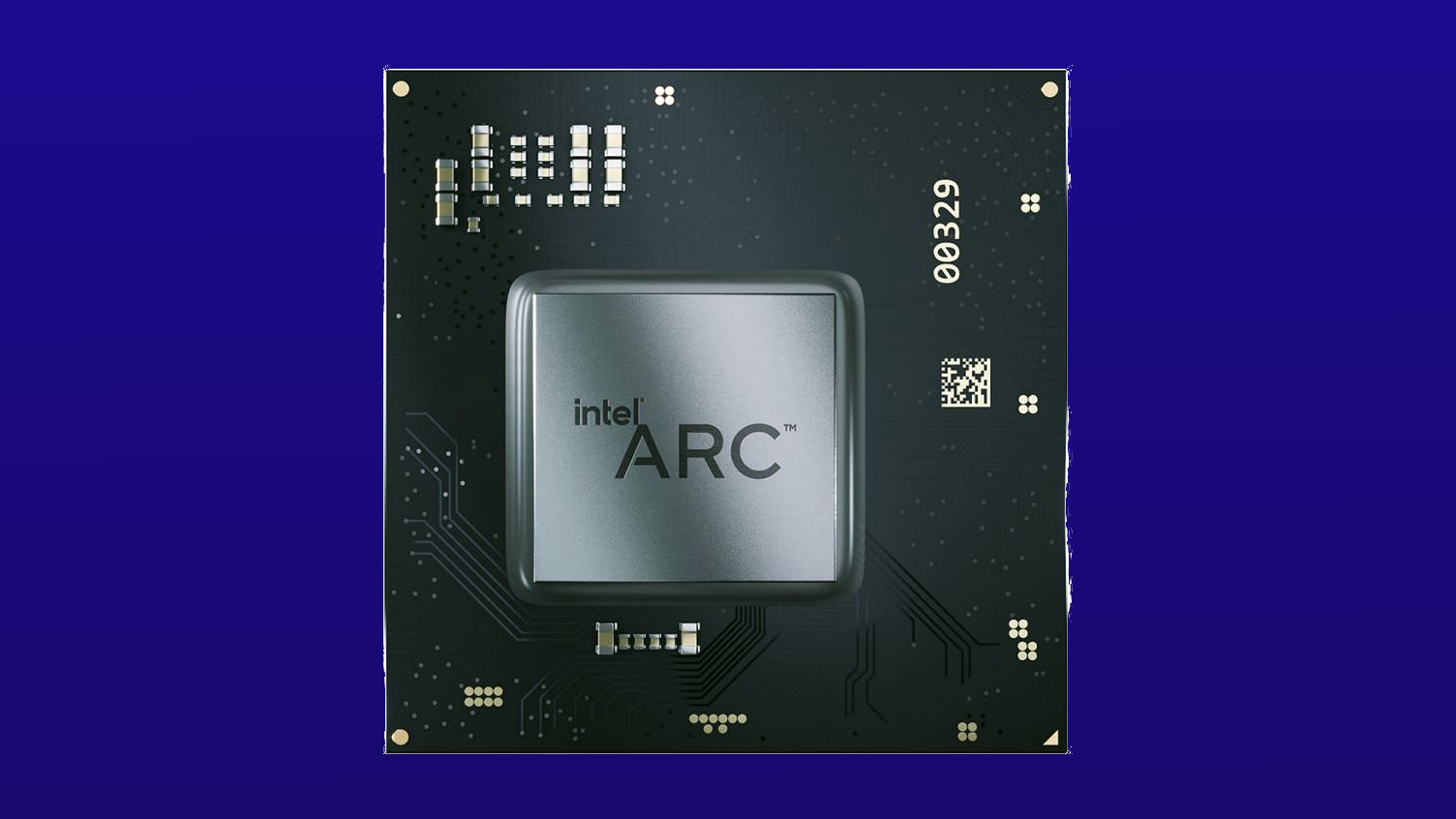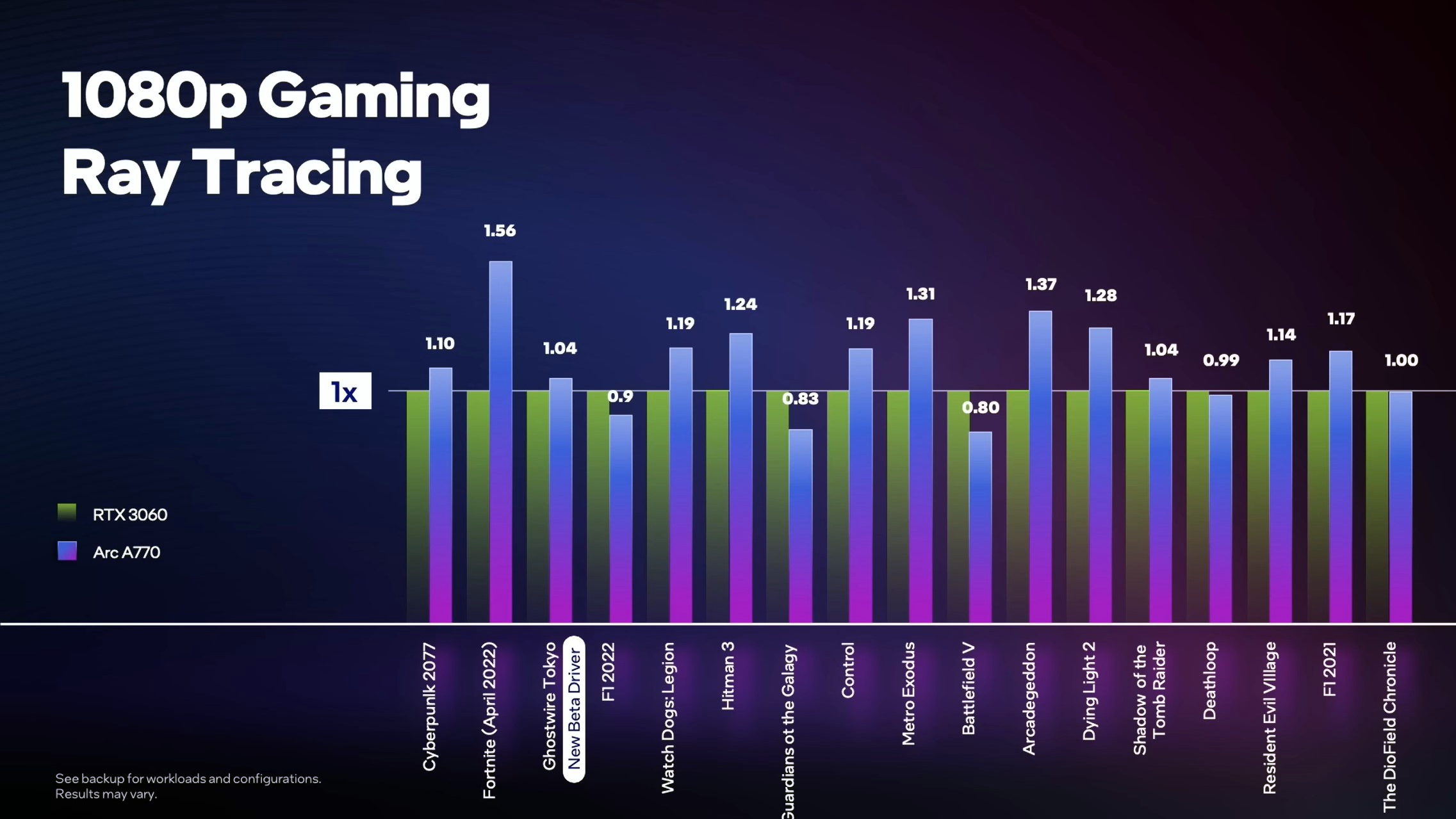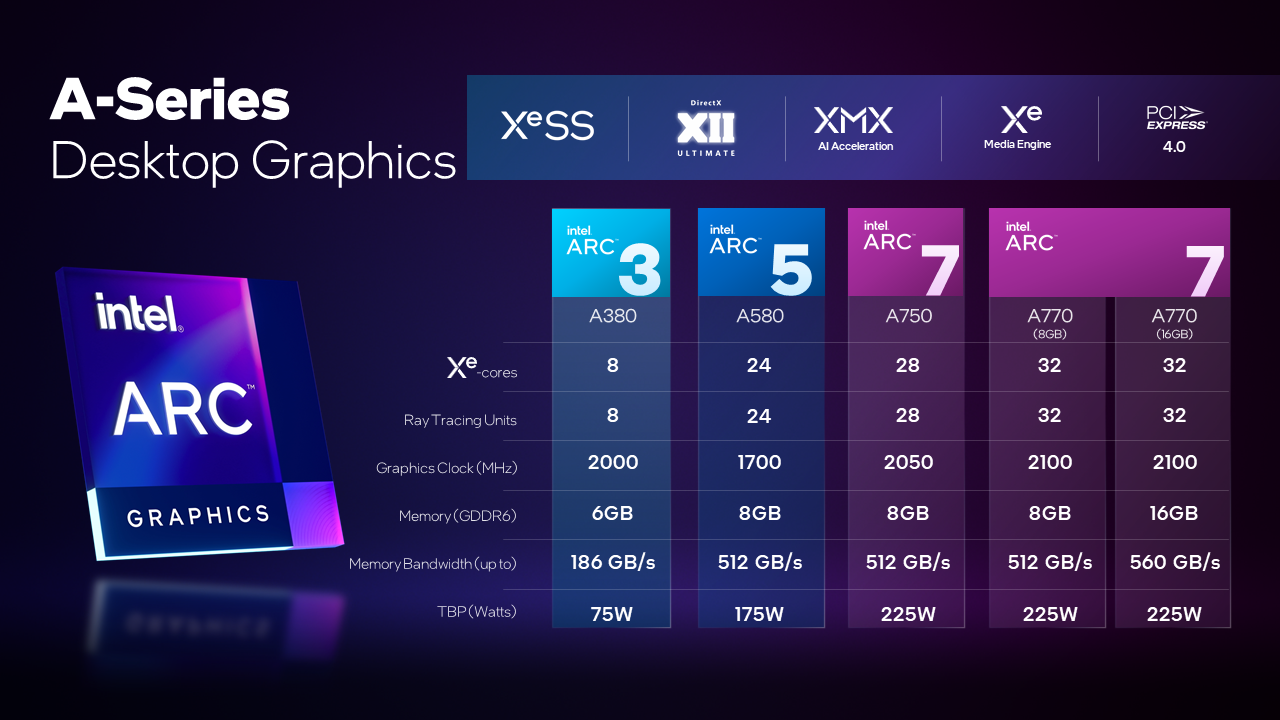Intel Arc A750 and A770 review roundup: A welcome third option
Reviewers seem pleasantly surprised by Intel's new GPU offerings, though there are some misgivings

The Intel Arc A750 and Intel Arc A770 graphics cards are set to launch on October 12 at $289 and $329, respectively. The A7-series cards are discrete GPUs that are more powerful than the Intel Iris Xe GPUs integrated into Intel CPUs found on some of the best computers. Now that the Arc A750 and A770 are almost here, Intel is in a position to challenge Nvidia and AMD for a significant piece of the graphics card market, which is hotter than it's ever been. It's worth getting excited about.
With the Arc A750 and Arc A770 on the horizon, the first round of reviews have begun popping up across the internet. Generally speaking, reviewers seem impressed by the budget-focused GPUs and were surprised by how well they fared against Nvidia’s similarly budget-friendly offerings, such as the Nvidia GeForce RTX 3060 and Nvidia GeForce RTX 3060 Ti. However, some benchmarks revealed less-than-stellar performance for older titles using older drivers.
Here’s what some of the biggest tech sites have to say about these new Intel Arc graphics cards.

Tom’s Hardware
Reviewing the Arc A770 for sister site Tom’s Hardware, Jared Walton believes Intel’s foray into the GPU market has potential – though he still says AMD and Nvidia cards are a safer bet since they’re known quantities. Walton says that Intel’s GPUs will face a tough fight against AMD’s Ryzen 7000 and Nvidia’s RTX 40-series graphics cards.
The good
“While the Arc A380 technically arrived first, the Intel Arc A770 represents Team Blue's best foot forward for the graphics card market. We can't say it's perfect or even a better option than the competing AMD and Nvidia cards, particularly if you play a wider selection of older DX11 (or earlier) games, but compared to the A380 just one month ago, the overall experience is much improved. If Intel can keep iterating on the drivers for a few more months, it could be a serious competitor in the midrange market.”
“Intel also has some other interesting ideas. One is Smooth Sync, which obscures screen tearing with vsync off by blurring the boundary between the current and previous frames. It wasn't quite ready for use when the A380 first started getting into reviewers' hands, but after running everything in the current test suite with Smooth Sync enabled, I can say that I never noticed tearing as a problem. Others might be more keen-eyed, but it's an interesting alternative to getting a more expensive adaptive sync display with a high refresh rate.”
Get instant access to breaking news, the hottest reviews, great deals and helpful tips.
The bad
“We have a modest test suite that's public knowledge. It consists of 14 widely known and benchmarked games — just the kind of stuff Intel should be optimizing around for a new GPU launch. Still, we ran into a few problems and idiosyncrasies during testing. For example, most of our standard test suite worked fine, but Red Dead Redemption 2 would run in a window when selecting full screen. The workaround was to change the desktop resolution to whatever resolution we wanted to use in the game, at which point things worked more or less properly (and performance improved).”
“Our ray tracing test suite didn't fare quite so well. First, the Bright Memory Infinite Benchmark seemed to experience a memory leak that caused degraded performance over time. About midway through the first run, performance dropped on the A750, and subsequent runs got worse until, eventually, the only real option was to quit and restart the game. Fortnite had a bug with the 3433 drivers that prevented it from launching; 3435 fixed the situation. Finally, Minecraft Bedrock (the Windows Store version) still hasn't whitelisted the Arc GPUs to allow the use of ray tracing, which means we can't run that particular benchmark right now.”
Engadget
In his review of the Arc A750 and A770 for Engadget, Devindra Hardawar seems pleasantly surprised by Intel’s GPU offerings. Though he is hesitant to wholeheartedly recommend these graphics cards, Hardawar says that it’s hard to beat the GPUs’ budget-friendly prices.
The good
“I figured the beefier Arc A770 would outmatch the RTX 3060 Ti (I didn't have a chance to review the 3060 at launch), but I was genuinely surprised by how well both cards faired in our benchmarks. The A750 scored over 900 more points than the 3060 Ti in the 3DMark Time Spy Extreme benchmark, landing just above the RTX 3070. I was also able to hit 74 fps while playing Halo Infinite in 1440p with all of the graphics settings maxed out. That's not at all what I expected from a GPU under $300.”
The bad
“Despite a few hiccups, like not getting ray tracing in Control and occasional framerate hiccups in Cyberpunk, I was happy to see that Intel's Arc drivers didn't have any major issues. There were no game crashes or blue screens of death during my testing. Still, Intel needs to show it can optimize its drivers in time for major game launches (guaranteeing XeSS support in Modern Warfare II is a start). And given the company's complete abandonment of its previous discrete graphics card, Intel also has to prove that it won't just give up on these GPUs soon. Most gamers will need to rely on their video cards for several years, after all.”

Eurogamer
Will Judd from Eurogamer was similarly impressed by the Arc A750 and A770. Eurogamer’s benchmarks revealed performance comparable to the Nvidia RTX 3060. The Arc 770 sometimes came “surprisingly close” to the RTX 3060 Ti’s performance. However, Judd noted that older or incompatible software could impact a game’s performance.
The good
“For a first try, this is pretty good going. Beyond the surprisingly good frame rates, the unique mix of features here has been fascinating to explore - and there's plenty here that we didn't touch too, like overclocking.”
“Having XeSS is a nice feature in the handful of games that support it right now and is likely to become more of an asset as it is integrated by other developers. In RT titles particularly, having this tech on your graphics card is invaluable. However, XeSS remains the newcomer here, with FSR 2.0 supported in a few more games and DLSS remaining the best-supported option by a huge margin.”
The bad
“There are still weaknesses here, to be clear. You should not buy an Arc GPU if your PC doesn't support Resizeable BAR, as performance will plummet - to the tune of double-digit percentages. This technology is a nice-to-have on Nvidia and AMD GPUs, boosting frame rates marginally in some games by allowing the GPU to load data into memory in fewer transfers, but Arc's memory controller is built around having it and really doesn't run well without it.”
“Similarly, you can expect significantly lower framerates in older DX9 and DX11 titles. Shadow of the Tomb Raider runs 15 percent faster under DX12 than DX11 in our testing and Control is much the same, but you can also get worse frame health under these older APIs with more frequent stutters and spikes. These can be mitigated to an extent by dropping settings, but if you largely play older titles then Arc may not be for you - yet.”
The Verge
Tom Warren from The Verge found that the A750 proved capable of delivering 1080p experiences while the A770 fared similarly with 1440p resolution. However, he found the cards’ drivers “very basic” compared to AMD and Nvidia’s. Despite some reservations, Warren was still impressed by what the budget cards offered.
The good
“The Arc A750 and A770 have a very similar design, and all that separates them visually is a strip of LEDs that’s only available on the $349 limited edition A770 16GB. Both have a slick matte finish that barely picks up fingerprints and seems to be good at keeping dust at bay, too. These cards look great in a case with a side panel, and I think they’re just as visually appealing as Nvidia’s Founders Edition cards.”
“I’ve been testing a variety of games across both 1080p and 1440p and even Intel’s new XeSS competitor to Nvidia’s DLSS. The results are solid for both cards at 1080p, with the majority of games running at 60fps or far beyond with ultra or high settings enabled. At 1440p, the Arc A750 can’t always deliver beyond 60fps, particularly when ray tracing is enabled.”
The bad
“The biggest problem for XeSS right now is that there just aren’t enough games that support it yet. That could change in the coming months, but for now, Nvidia has an obvious lead here thanks to the amount of time it has been in the market and the 100-plus games that already support DLSS.”
“I also experienced a bunch of weird driver issues throughout my testing. Fortnite wouldn’t launch, so I initially chose not to benchmark it, and as I looked around for other first-person shooter options, I thought I’d give Valorant a go. That wouldn’t launch either. Intel issued a new driver to fix these issues, but these problems make me nervous given how broken the drivers were for Intel’s Arc A380. There are also signs that games will need to be updated to fully support Arc GPUs.”

XDA-Developers
Writing for XDA-Developers, Richard Devine found it “complicated” to answer whether or not users should buy the new Intel Arc GPUs. He says the cards are worth considering if you’re on a budget and want a lot of VRAM. However, if ray-tracing or playing older games is important, then you may want to reconsider.
The good
“We were promised RTX 3060 levels of performance and for the most part, Intel has delivered on that promise. You’re covered up to 1440p with high frame rates, high details, and a generally good time in newer games. This is a GPU built for the future, not the past. And while it can handle ray tracing, sometimes with astonishing results, this is a mid-range card. If ray tracing is important, you’ll still really want to spend more.”
The bad
“Running Borderlands 2 was fine, though again, wildly inconsistent frame rates. And not nearly as fast as you would perhaps think from an older game. But it works and is totally playable. The same can’t be said of Batman: Arkham Asylum, though. Things start out ok, but a couple of minutes into the game you get a complicated error message and a total crash.”
PC World
Brad Chacos of PC World says the Intel A7-series cards represent the company’s “first true challenge” to AMD and Nvidia. However, he feels Intel “didn’t fully stick the landing,” saying that Intel’s GPU architecture doesn’t perform to its fullest potential in every system or game.
The good
“Intel launching its debut Arc A7 desktop graphics cards is a momentous event for the computer industry. After decades of duopoly, a new player has entered the GPU game. While Arc isn’t perfect, it’s good enough to provide hope for a more competitive future.”
“There’s a lot to like with Arc. Intel’s Limited Edition cooler looks good and runs cool and quiet. Arc’s AV1 encoding performance blows away the competition. In games running DX12 or Vulkan, it can not only keep pace with the RTX 3060, it can sometimes absolutely crush Nvidia’s offering under its heel. Speaking of, Intel’s debut ray tracing implementation already topples the RTX 30-series’ RT cores and leaves Radeon GPUs eating dust, though DLSS’s widespread adoption gives Nvidia an overall edge there. Arc also shines at higher resolutions, with the A770 stretching its legs (and often, lead) at 1440p.”
The bad
“But enough quirks and oddities remain that its difficult to recommend Arc except in very niche circumstances. Intel admits that Arc’s DirectX 11 performance lags behind its rivals, and our testing showed that gulf to be significant. Most games still run on DX11. On top of that, you’ll need a modern system with support for PCIe Resizable BAR, or you’ll leave another huge chunk of performance on the table. Arc sucks down considerably more power than its Nvidia and AMD rivals, even when idling. And while Intel’s drivers are in much better shape than they were months ago, and thousands of engineers are squashing bugs and improving performance as quickly as possible, we still encountered several crashes and other software-related woes that you simply don’t see with GeForce or Radeon GPUs these days.”
Outlook
After taking the temperature of critics at some of the leading tech outlets, it's clear that Intel's new top-of-the-line Arc A7 cards have brought a much-needed breath of fresh air to the GPU market.
While many reviewers warned us about the headaches in store for early adopters of Intel's new cards, the promise of a GPU that's cheaper and more performant than Nvidia's GeForce RTX 3060 is good news for PC gamers. Hopefully Intel will move quickly to iron out technical problems, issue better drivers and get more game developers on board with XeSS and other Intel GPU tech.

Tony is a computing writer at Tom’s Guide covering laptops, tablets, Windows, and iOS. During his off-hours, Tony enjoys reading comic books, playing video games, reading speculative fiction novels, and spending too much time on X/Twitter. His non-nerdy pursuits involve attending Hard Rock/Heavy Metal concerts and going to NYC bars with friends and colleagues. His work has appeared in publications such as Laptop Mag, PC Mag, and various independent gaming sites.
